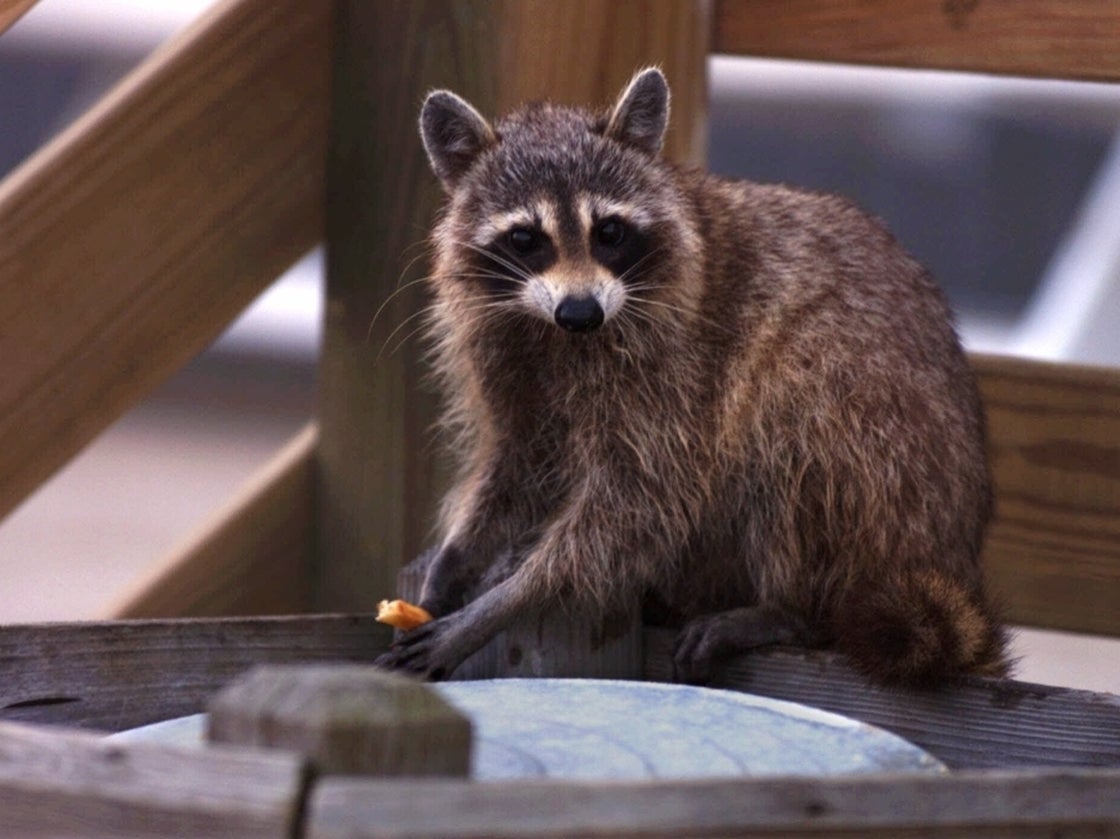Raccoon sightings on the rise in Northwest Philly

(Bob Jordan/AP images)
Ilana Ginsburg got quite a surprise when she was driving home on June 1.
There was a raccoon looking at her from the bushes by her neighbor’s house on West Mt. Airy Avenue.
She was half a block from the intersection of Bryan Street and Mt. Airy Avenue, which was packed with more than 100 people talking, eating dinner, and listening to live music in the late afternoon at the annual “Walk and Talk” block party held by the Mt. Airy-Nippon-Bryan-Cresheim Town Watch.
Earlier that same day Beth Vogel, also a resident of the neighborhood, had a similar experience.
“I was walking back from getting my morning coffee at the High Point Café” she said, “when I saw this humongous raccoon right on the sidewalk. It growled at me.”
Experiences like those of Ginsburg and Vogel have become increasingly common. Ginsburg described the raccoon she saw on June 1, for example, as “not the largest, not the smallest,” of the four or five others she had seen in the area on other occasions.
Then, Durham Street resident Huntley Collins emailed the town watch’s listserv tell the neighborhood she had found a half-eaten bat on her porch and that her neighbor’s cat was bitten by a raccoon. The emails from other residents started pouring in.
Some of the sightings were at night. Collins said the raccoons often could be seen running up and down a narrow backyard walkway between the houses on Durham Street and Mt. Airy Avenue in the early evening.
Daytime sightings significant?
Many residents worried the increase in daytimes sightings was a sign of rabies.
According to Rick Schubert, director of the Wildlife Clinic at the Schuylkill Center for Environmental Education in Roxborough, raccoons in daylight is not that unusual, especially this time of the year.
March through August marks breeding time for raccoons. Raccoons are very active then, foraging for food during the daytime as well as at night, Schubert explained.
Deb Welter operates the Diamond Rock Wildlife Clinic in Malvern, which specializes in the treatment of injured or orphaned animals, principally raccoons. The clinic is currently raising 35 young raccoons. “Most of them have been brought to me because the mother has been killed,” she said.
She concurred with Schubert’s assessment that there’s no connection between rabies and daytime raccoon sightings.
“It’s a myth,” said Welter. “At this time of year mothers have to get out whenever they can. Baby raccoons are voracious eaters.”
Why they’re here
“They’re trying to do the same things that we do: find a safe place and find food and raise a family,” said Welter.
“The trash in the city is 100 percent the reason they are here,” said Schubert. “If there is plenty of trash and garbage in a place, there will be plenty of raccoons.”
In Toronto, it is estimated that about 100,000 raccoons live within the city limits. The raccoon population boom is often attributed to the introduction of plastic recycling bins that aren’t raccoon-proof.
Philadelphia’s raccoon population is not as large but raccoon infestations and encounters are far from uncommon in the Northwest, given its proximity to the Wissahickon Valley.
“In the last few years I’ve given a number of programs about raccoons in Northwest Philadelphia – Chestnut Hill, Mt. Airy, Germantown. Some people were afraid to come out of their houses because of what they saw as marauding raccoon gangs, even though it wasn’t true,” said Welter.
Rabies fears and facts
Raccoons can suffer from a number of diseases, said Schubert, including viral infections, distemper, mange and rabies.
While rabies is present throughout Pennsylvania, confirmed cases aren’t common in the city.
Jeff Moran, spokesman for the city’s Health Department, said there have been no laboratory-confirmed cases of rabies in Philadelphia in 2013 so far. 2012 saw a total of four confirmed cases.
That includes an incident in May 2012 near Valley Green Inn, where a hiker was bitten by a raccoon that was captured and tested positive for the disease.
While bites are the most common way that the disease is transmitted to humans, Welter added, “It’s transmitted by saliva, so you don’t want to be licked by even the cutest little baby raccoon.”
“I do think that a wise person should assume that wildlife is not safe for a number of reasons. I know that rabies exists in the counties in our area. Part of our job is to make sure that everyone’s pets are vaccinated for rabies, even indoor cats,” according to executive director of the city’s Animal Care and Control Team (ACCT), Sue Cosby.
What the city will do
Cosby said the city will remove a raccoon from your propery in certain cases.
ACCT will remove the raccoon if it is in a “common area” of the home, such as a living room or bedroom, she said. But they won’t if it’s in the attic, cellar, or crawlspace.
“In a common area it’s directly impacting public health and safety. In the attic or crawlspace, it’s a nuisance,” said Cosby.
In those cases the owners are responsible for removing the raccoon by driving it away or trapping it.
The policy is set by the Pennsylvania Game Commission which is responsible for wildlife management throughout the state.
ACCT will also respond to reports of sick, injured or immobile animals, said Cosby. Observers can call (215)385-3800 to report sightings.
According to the ACCT’s website, by law, animals removed by ACCT are euthanized once captured.
Reducing the attraction
Cosby, Schubert, and Welter all agreed that the most important way to reduce the raccoon presence in an area is to minimize the amount of food available to them. Since raccoons will eat anything, that’s not always an easy task.
Keeping trash cans inside with tight-fitting lids and bringing in bird feeders or food put out for wild cats at night can help, according to Welter.
Regardless of the precautions, residents should be prepared to encounter the occasional raccoon, said Schubert.
“Remember, raccoons are here to stay. Neither of us is going anywhere.”
For more information about raccoons in Philadelphia visit the ACCT website.
WHYY is your source for fact-based, in-depth journalism and information. As a nonprofit organization, we rely on financial support from readers like you. Please give today.




